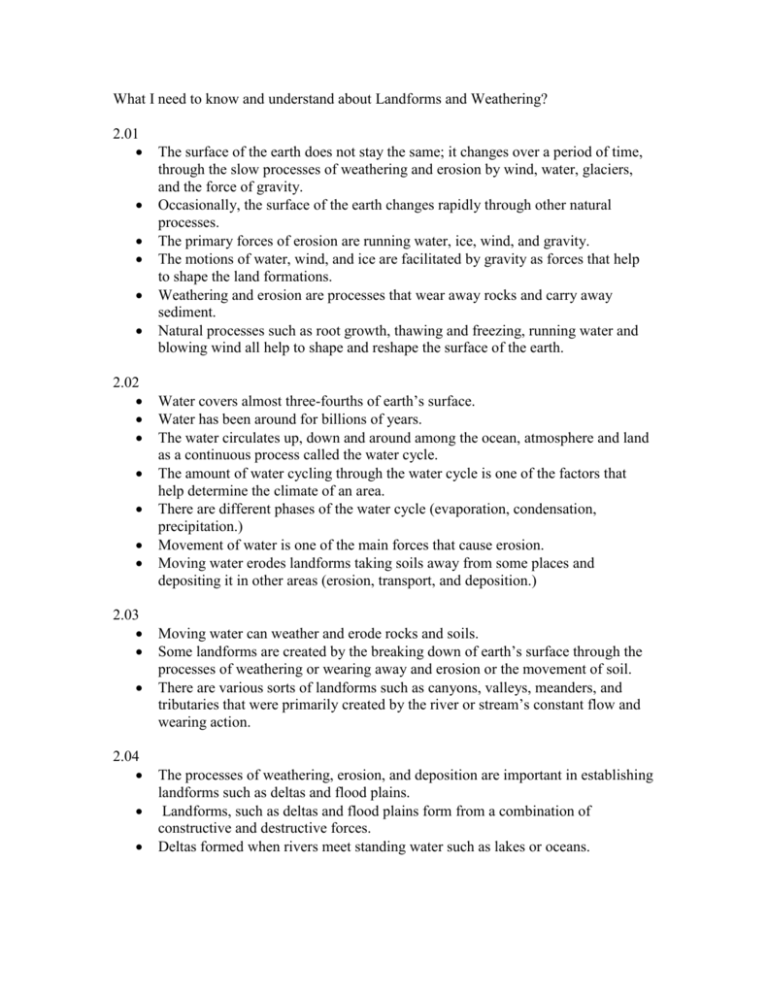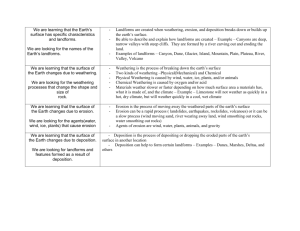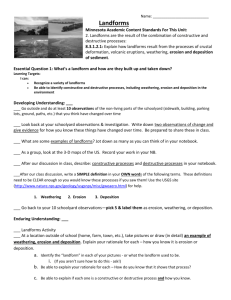What I need to know and understand about
advertisement

What I need to know and understand about Landforms and Weathering? 2.01 2.02 2.03 2.04 The surface of the earth does not stay the same; it changes over a period of time, through the slow processes of weathering and erosion by wind, water, glaciers, and the force of gravity. Occasionally, the surface of the earth changes rapidly through other natural processes. The primary forces of erosion are running water, ice, wind, and gravity. The motions of water, wind, and ice are facilitated by gravity as forces that help to shape the land formations. Weathering and erosion are processes that wear away rocks and carry away sediment. Natural processes such as root growth, thawing and freezing, running water and blowing wind all help to shape and reshape the surface of the earth. Water covers almost three-fourths of earth’s surface. Water has been around for billions of years. The water circulates up, down and around among the ocean, atmosphere and land as a continuous process called the water cycle. The amount of water cycling through the water cycle is one of the factors that help determine the climate of an area. There are different phases of the water cycle (evaporation, condensation, precipitation.) Movement of water is one of the main forces that cause erosion. Moving water erodes landforms taking soils away from some places and depositing it in other areas (erosion, transport, and deposition.) Moving water can weather and erode rocks and soils. Some landforms are created by the breaking down of earth’s surface through the processes of weathering or wearing away and erosion or the movement of soil. There are various sorts of landforms such as canyons, valleys, meanders, and tributaries that were primarily created by the river or stream’s constant flow and wearing action. The processes of weathering, erosion, and deposition are important in establishing landforms such as deltas and flood plains. Landforms, such as deltas and flood plains form from a combination of constructive and destructive forces. Deltas formed when rivers meet standing water such as lakes or oceans. 2.05 2.06 2.07 When rivers meet standing water the rivers energy is decreased therefore, the sediment that was flowing along with the river settles and is deposited in the area where the flowing water meets the standing water. Flood plains are land located on or around lakes, rivers, or streams. During periods of overflow or floods, the land areas beside these water sources are covered. Some land forms are made by the slope of the land and the amount of running water. Water running down hill is a dominate erosion process; the steeper the slope the more material that will be eroded. The slope of an area and the amount of water delivered to that area over a given amount of time contributes to the erosion of the land. Landforms that result from running water include canyons, deltas, and alluvial fans. The slope of an area and the amount of water delivered to an area contributes to the rate of the erosions. Maps are abstractions of realities and can represent large or small areas. Maps and models are ways of representing information about your neighborhood, city, state, county, waterways; even a floor plan could be considered a map of your home. Land use impacts erosion and deposition of soils. Humans can have a positive and negative affect on the land. Humans affect the topography or geography of the land. Erosion carries away soil particles. Deposition is the process of depositing transported or eroded materials. Vegetation helps to decrease the rate of erosion. Dams assist in the containment of water to prevent flooding and erosion.








